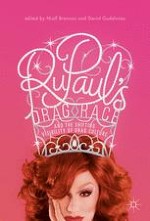2017 | OriginalPaper | Chapter
Digital Extensions, Experiential Extensions and Hair Extensions: RuPaul’s Drag Race and the New Media Environment
Author : David Gudelunas
Published in: RuPaul’s Drag Race and the Shifting Visibility of Drag Culture
Publisher: Springer International Publishing
Activate our intelligent search to find suitable subject content or patents.
Select sections of text to find matching patents with Artificial Intelligence. powered by
Select sections of text to find additional relevant content using AI-assisted search. powered by
